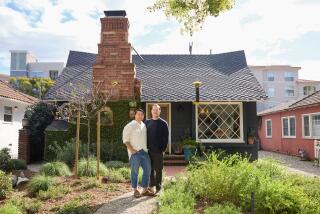Interesting Pathways Begin With Choice of Stone, Style to Match the Surroundings
- Share via
When landscape designers are faced with the task of creating an interesting environment, some of the most powerful tools they can use are the varied paving materials available today. The choice of material for a walkway, for instance, can dramatically alter the feeling of an outdoor area--whether it is a short passage from a driveway to the front door or a meandering footpath through a large country garden.
The options available are limited only by one’s imagination. The most commonly seen materials are poured or precast concrete, and though these walks are quite serviceable, they’re also rather uninteresting.
Other choices are more eye-catching. A brick or cut-slate walk, for example, suggests a formal elegance and makes reference to Colonial American design. A walk fashioned of wooden decking or blocks or rounds cut from a log has a casual feeling and may be most appropriate for a retreat or summer home. A walk of randomly shaped flagstones falls somewhere between the previous alternatives in the feeling it conveys.
The variety of sizes and shapes of the stones creates an interesting texture, while maintaining a feeling of solidity and permanence. Flagstone is an excellent option in many situations.
*
A stone walk can be installed three different ways. The first method involves setting the stones directly on the soil and letting grass or a ground cover grow around each stone--a series of steppingstones. Another system is to set the stones in concrete. The third procedure, and the one which we used, is to set the flagstones on a base of crushed stone, and to fill the joints with the same crushed stone. This method yields a permanent and stable walk that still has a rustic feel and fits well in a garden location.
Flagstone is generally available as either slate or sandstone. In many cases, most of the irregularly shaped stones are sandstone; slate is sold in square-edged rectangular sizes.
When flagstone is taken from the quarry, it is split from the bedrock, rather than cut. This technique results in stones of varying thickness. Flagstone is generally sold by the square foot. There can be some waste, particularly if you want a look that’s primarily large stones. To be sure that you have enough material to complete your project, measure the area to be paved and add about 15% to allow for breakage and fitting.
To form the base for your walk, you will need a quantity of crushed stone. This material is sold under several names but is most widely known to stone suppliers as dolomite dust or “1-Bs.” This is a combination of very small stone chips and dust. It forms a stable base and provides good drainage. In addition, when used as a filler between the stones, it compacts well to lock the stones in place and provides a poor medium for weed growth.
In areas of the country where severe winters are a factor, a base of 4 inches of crushed stone is recommended. To determine how much stone to buy, take the square footage of your path and divide by three to give the amount of crushed stone in cubic feet. Divide that figure by 27--there are 27 cubic feet per cubic yard--to give the amount in cubic yards.
Most stone suppliers sell either by the cubic yard or by the ton. For crushed stone, you can figure 1 1/2 tons per cubic yard. Again, add an additional 10% to 15% for filling joints and building up thinner stones.
